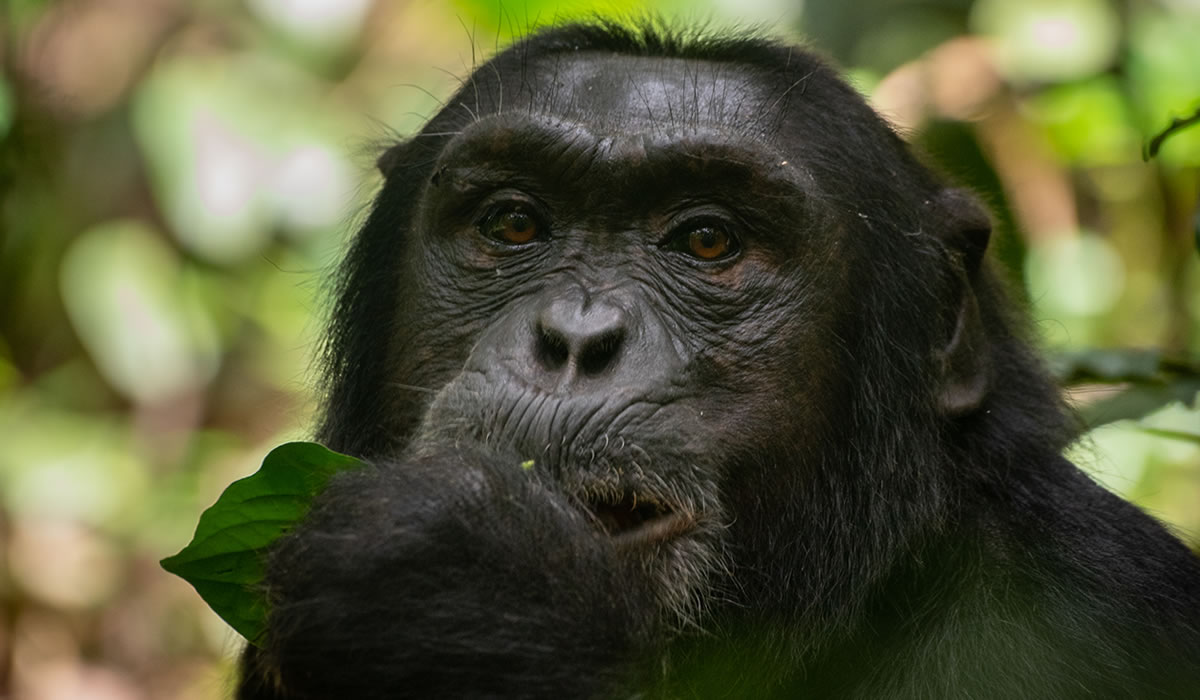Tucked away in western Uganda, Kibale Forest National Park is one of Africa’s premier destinations for primate tracking and tropical biodiversity. Spanning approximately 795 square kilometers, the park consists largely of tropical rainforest, interspersed with swamps, grasslands, and riverine areas. It lies near the foothills of the Rwenzori Mountains and is contiguous with Queen Elizabeth National Park to the south, creating a vast conservation corridor rich in flora and fauna. Established in 1993, Kibale is best known for its high concentration of primates especially chimpanzees, but it is also a haven for birdwatchers, botanists, and nature lovers.
Kibale Forest National Park is often referred to as the “Primate Capital of the World”, and for good reason. The park is home to 13 species of primates, the highest concentration in Africa. Foremost among these are the chimpanzees, with an estimated population of over 1,500 individuals. Several communities have been habituated to human presence, offering visitors the rare and unforgettable opportunity to observe our closest living relatives in their natural habitat.
In addition to chimpanzees, other primates found in the park include the red colobus, black-and-white colobus, L’Hoest’s monkey, blue monkey, grey-cheeked mangabey, vervet monkey, olive baboon, and the potto, a nocturnal primate rarely seen during the day. The diversity and density of these species make Kibale one of the most important primate conservation areas in Africa.

Activities in Kibale Forest National Park
1. Chimpanzee Tracking
The highlight of any visit to Kibale is chimpanzee tracking. Daily excursions set off from the Kanyanchu Visitor Centre, typically in the morning and afternoon. Trained Uganda Wildlife Authority (UWA) guides lead small groups into the forest in search of habituated chimpanzee communities. The treks can last anywhere from one to four hours, depending on the location of the chimpanzees, and once located, visitors are allowed to spend up to one hour observing their behaviors, social interactions, and vocalizations.
Chimpanzee tracking in Kibale is considered one of the best in Africa due to the high success rate of sightings—averaging around 90%. The chimps are relatively used to human presence, allowing for fantastic photo opportunities and memorable encounters.
2. Chimpanzee Habituation Experience
For a more immersive experience, Kibale offers the Chimpanzee Habituation Experience, which allows visitors to spend a full day with a chimpanzee group undergoing the habituation process. This unique opportunity provides a deeper understanding of chimpanzee behavior and forest ecology, and involves joining researchers and rangers in the forest from dawn until dusk.
3. Nature Walks and Forest Hikes
In addition to chimpanzee tracking, Kibale offers a variety of guided nature walks. These walks explore the forest’s rich plant life and offer a chance to see other primates, birds, butterflies, and small mammals. The Bigodi Wetland Sanctuary, located just outside the park in the Magombe Swamp, is a particularly rewarding place for eco-walks. Managed by the local community, it supports hundreds of bird species and several monkey species, including the rare red colobus and L’Hoest’s monkey.
Night walks are also available and offer the chance to spot nocturnal creatures like the galago (bush baby), potto, nightjars, and tree hyraxes. Armed with spotlights and accompanied by guides, visitors experience a very different side of the forest under the cover of darkness.
4. Bird Watching
Kibale is one of the best birding destinations in Uganda, with over 370 species recorded in the park. Notable among these are the African pitta, green-breasted pitta, grey parrot, great blue turaco, black bee-eater, and white-naped pigeon. Birding can be done inside the forest, around the Bigodi Wetland, and along the grassland and edge habitats. Experienced birding guides help identify both common and elusive species, making it a rewarding activity for both amateur and seasoned birders.
5. Cultural Encounters and Community Tours
Beyond wildlife, Kibale also offers a window into Uganda’s rich cultural heritage. Visitors can explore nearby villages, visit local schools, learn about traditional farming methods, and even participate in banana beer brewing or basket weaving. The Bigodi Wetland Sanctuary is a shining example of community-based tourism, with proceeds from tours contributing to education, healthcare, and conservation projects in the area.
Things to See in and Around the Park
Kibale is not only about primates; the forest and its surroundings are teeming with biodiversity and scenic beauty. Apart from chimpanzees, visitors may encounter forest elephants, duikers, bush pigs, and buffaloes. Although rarely seen, leopards and golden cats are also present in the park.
The forest itself is a natural wonder, with giant fig trees, towering hardwoods, and a thick undergrowth teeming with life. Butterflies, insects, fungi, and epiphytic plants contribute to the forest’s rich ecosystem. The park’s swampy areas and grasslands offer contrasting scenery and are excellent for spotting unique flora and fauna.
Nearby attractions include:
- Crater Lakes Region: Located just south of the park, this area is dotted with scenic volcanic crater lakes and offers stunning views, ideal for hiking and photography.
- Rwenzori Mountains National Park: Located further west, this park is a hiker’s dream and offers multi-day treks into the high peaks of the “Mountains of the Moon.”
- Queen Elizabeth National Park: Connected to Kibale via the “Mweya-Kasese” corridor, this park offers classic savannah game drives, boat cruises, and tree-climbing lions.
Best Time to Visit
Kibale Forest National Park can be visited year-round, but some seasons are more favorable than others depending on the traveler’s priorities.
Dry Seasons (December to February and June to September)
These are considered the best times for chimpanzee tracking and forest hikes. Trails are drier and more navigable, and wildlife is easier to spot as vegetation is less dense. The weather is generally more predictable, and the chances of rainfall are lower.
Wet Seasons (March to May and October to November)
While the forest is lusher and the landscape more vibrant during the rainy seasons, the trails can become muddy and slippery, making trekking more difficult. However, this is also a great time for birding, as many species breed during the rains, and migratory birds are present. It’s also the low tourist season, which means fewer crowds and lower accommodation rates.
Where to Stay
Kibale offers a variety of accommodation options ranging from luxury eco-lodges to mid-range lodges and budget guesthouses. Most accommodations are located near Kanyanchu, the main chimp tracking starting point, or in nearby areas such as Fort Portal, Ndali, or Bigodi.
Luxury Lodges
- Kyaninga Lodge: Located near Fort Portal, this upscale lodge features luxury cottages overlooking a crater lake and the Rwenzori Mountains.
- Crater Safari Lodge: Situated on the edge of Nyinabulitwa Crater Lake, this eco-lodge offers luxury cottages with breathtaking views.
- Ndali Lodge: A historic lodge with panoramic views of the Rwenzoris and crater lakes, offering comfort and charm.
Mid-Range Lodges
- Primate Lodge Kibale: Located within the park, just a few meters from the chimp tracking starting point, this lodge offers convenience and comfort.
- Chimpanzee Forest Guest House: A charming guest house in a colonial-style building with scenic views and access to crater lakes.
Budget Options
- Kibale Forest Camp: A great budget option offering safari tents and bandas just outside the park.
- Rweteera Safari Park: Offers basic accommodation near the park with easy access to crater lake activities.
How to Get There
Kibale Forest National Park is relatively easy to access, especially from major towns in western Uganda.
By Road
From Kampala, the capital city of Uganda, the park is about 320 kilometers (a 5–6-hour drive) via the Kampala-Mubende-Fort Portal route. The roads are generally in good condition, and Fort Portal, the nearest major town, serves as a convenient base for trips into the park.
Travelers coming from Queen Elizabeth National Park can reach Kibale in about 2–3 hours, using the route through Kasese and Fort Portal.
By Air
For those who prefer to skip the drive, chartered flights can be arranged from Entebbe International Airport to Kasese Airstrip, which is about 1.5 to 2 hours from Kibale by road. From there, a transfer can be organized to your lodge.
Conservation and Responsible Tourism
Kibale Forest National Park plays a crucial role in primate conservation and forest preservation. The Uganda Wildlife Authority, along with various NGOs and research organizations, conducts vital work in studying and protecting the park’s unique ecosystem. Tourist revenue helps fund these efforts and supports surrounding communities.
Visitors can contribute to conservation by respecting park rules, hiring local guides, choosing eco-friendly accommodations, and supporting community tourism initiatives such as those in Bigodi. Simple actions like avoiding plastic waste, staying on designated trails, and maintaining a respectful distance from wildlife all help preserve the delicate balance of this pristine forest.
Kibale Forest National Park is a gem in Uganda’s tourism crown, a lush, vibrant sanctuary where the call of a chimpanzee echoes through the forest canopy and the stillness of nature envelops every step. Whether you come for the thrill of tracking primates, the serenity of a forest walk, the excitement of rare bird sightings, or the chance to connect with local communities, Kibale offers an experience that is as profound as it is exhilarating. For those seeking to immerse themselves in the beauty and complexity of the natural world, Kibale is a destination not to be missed.

